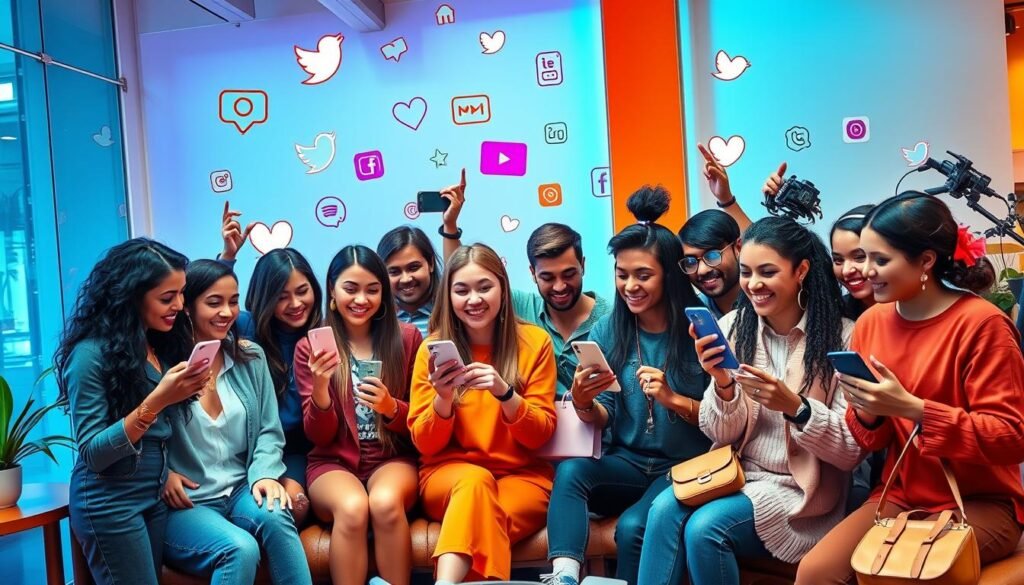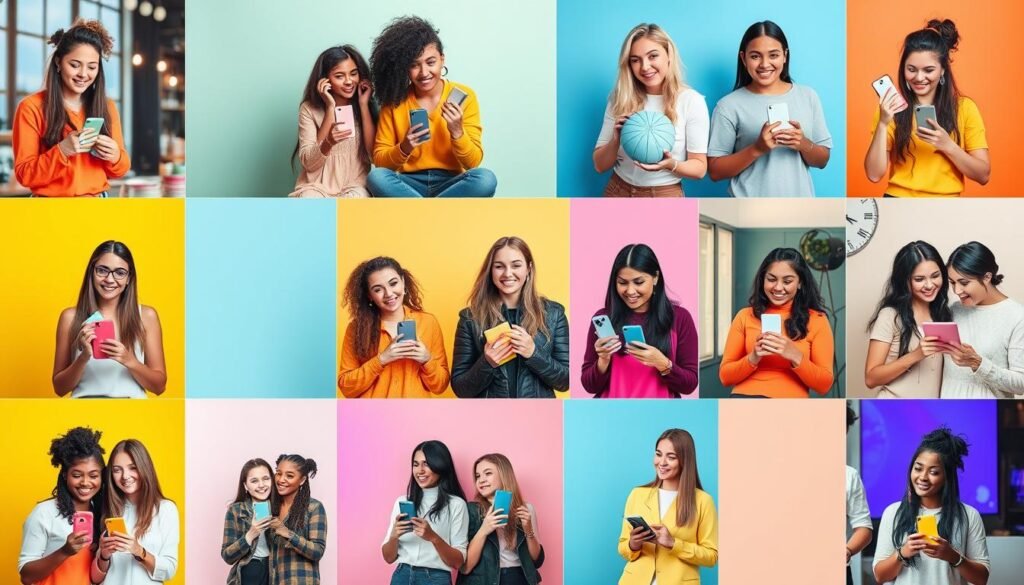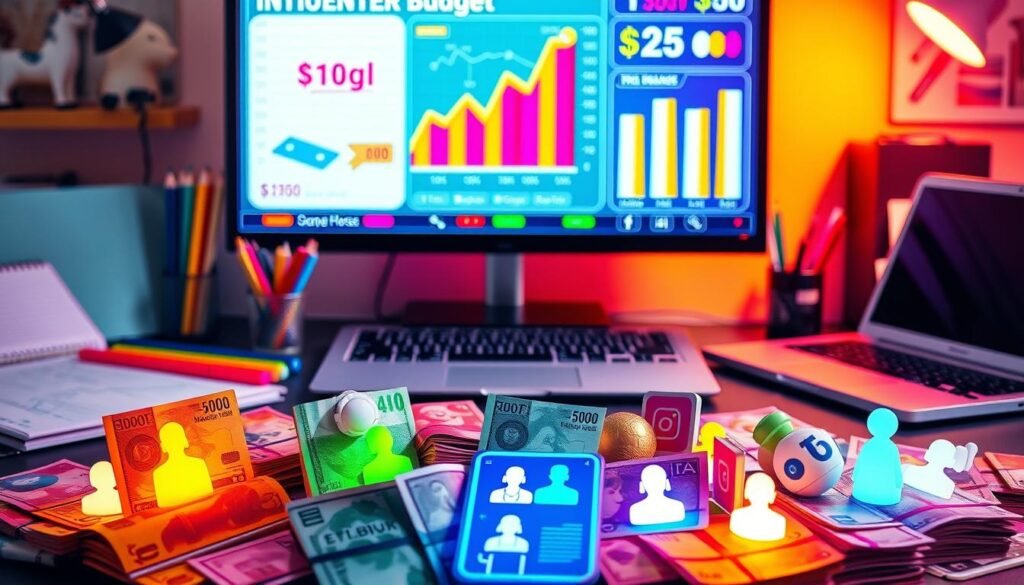In the world of digital marketing, influencer marketing has become a key player. But why are smart brands putting a lot of money into it? What makes it such a strong tool for marketing today?
Influencer marketing has grown from just a trend to a key part of today’s ads. It brings real value and results. Leaders say it can really boost your brand. It lets businesses use online stars to connect with people, get more engagement, and see real results.
Key Takeaways:
- Influencer marketing is now a big part of modern marketing, offering real value and results.
- Businesses can use online stars to reach people, get more engagement, and see real results.
- Influencer marketing lets brands tap into the trust and realness that influencers have with their fans.
- Good influencer marketing can make your brand more known, get more people involved, and increase sales and money made.
- Adding influencer marketing to your marketing plan can help your brand shine in a busy online world.
Unlocking the Power of Influencer Marketing
Influencer marketing is a strong strategy for businesses. It helps them connect with their audience. By working with social media influencers, brands gain trust and credibility. This leads to more awareness, engagement, and sales.
Defining Influencer Marketing
Influencer marketing is when businesses team up with influential people online. These influencers promote brands on their platforms. They use their realness and knowledge to sway their followers.
The Growing Influence of Influencers
The influencer marketing industry is set to hit $21.1 billion by 2023. 89% of marketers want to spend more on it. People, especially millennials and Gen Zers, trust influencers more than celebrities.
Influencer marketing is now key in marketing. It helps brands achieve real goals. Companies see the value of social media influence and brand-influencer partnerships in building trust and engagement.
“Influencer marketing can result in an average ROI of $6.50 for every dollar spent.”

By using influencers, businesses can reach and engage their audience. This builds consumer trust in influencers. It also brings real results to influencer marketing strategies.
Types of Influencer Marketing Campaigns
Influencer marketing is a strong tool for brands to reach their audience and get real results. Brands use Influencer Affiliate Campaigns and more to boost sales and grow their audience.
Affiliate or Discount Codes
Brands give influencers special discount codes to share. This method is great for making sales, as 93% of creators like to help out if they love the brand and the product.
Contests and Giveaways
Hosting contests and giveaways is a smart move for brands. It helps them connect with the influencer’s followers and grow their own audience. Everyone wins when products are given away.
Sponsored Posts
Influencer Sponsored Content is when an influencer promotes a brand for money. It’s a good way to reach more people and make the brand known, as 63% of marketers find it works better than their own content.

“Influencers return an average of $5.20 for every $1 spent by brands, compared to $2.63 for traditional advertising.”
The Different Types of Influencers
In the world of influencer marketing, there are many types of influencers. From Mega Influencers to Nano Influencers, each has its own benefits for brands. They help brands reach more people and connect with their audience.
Mega Influencers: These influencers have over 1 million followers. In 2023, top-paid ones include Cristiano Ronaldo and Kylie Jenner. They can make a lot of money from a single post, but may not have a personal connection with their followers.
Macro Influencers: They have 100,000 to 1 million followers. Influencers like Amy Jackson and Charlie Berens offer a balance between size and personal touch. They help brands connect with a large audience.
Micro Influencers: They have 10,000 to 100,000 followers. Known for their deep knowledge and high engagement, micro-influencers like Alina Gavrilov are cost-effective. They offer a personal touch to brands.
Nano Influencers: They have fewer than 10,000 followers. Despite their small audience, nano-influencers like Lonni Smith are authentic and engaging. They are great for reaching local communities.
Choosing the right influencer depends on the brand’s goals and audience. Brands should pick between mega, macro, micro, or nano influencers based on their needs.
| Influencer Type | Followers | Examples | Key Benefits |
|---|---|---|---|
| Mega Influencers | 1 million+ | Cristiano Ronaldo, Kylie Jenner, Leo Messi, Selena Gomez | Broad reach and brand awareness |
| Macro Influencers | 100,000 to 1 million | Amy Jackson, Charlie Berens, Ashley Galvin | Balanced reach and engagement |
| Micro Influencers | 10,000 to 100,000 | Alina Gavrilov, Francesca Newman-Young, Lonni Smith, Russ Crandall | High engagement and industry expertise |
| Nano Influencers | Less than 10,000 | N/A | Authentic engagement and hyper-local reach |
The world of influencer marketing is vast and varied. It offers brands many ways to reach their audience. By understanding each type’s strengths, brands can create effective influencer strategies.

Building an Effective Influencer Marketing Strategy
Creating a great influencer marketing plan starts with knowing your audience. Look at their demographics, interests, and where they hang out online. This helps pick influencers who match your brand’s goals. It’s key to make sure the influencer and audience fit well together.
For a campaign to succeed, set clear goals. You might want to boost brand awareness, increase sales, or grow your audience. Having clear Influencer Marketing Campaign Goals helps you see how well your campaign is doing. It also guides your future plans.
| Audience Targeting Approach | Key Considerations |
|---|---|
| Demographic Targeting | Age, gender, location, income level, occupation |
| Psychographic Targeting | Interests, values, lifestyle, personality traits, behavior patterns |
| Influencer-Audience Alignment | Ensuring the influencer’s audience matches your target market |
By matching your Audience Targeting with your Influencer Marketing Campaign Goals and Measurable Objectives, you can make a solid plan. This plan will help you check how well your campaign is doing. It also helps your brand grow in the long run.
“Influencer marketing is set to be worth $22.2 billion in 2025, indicating substantial growth and investment by brands in this marketing strategy.”
Leveraging the Power of Micro-Influencers
In the fast-changing world of influencer marketing, micro-influencers are key. They help brands reach specific groups of people. These influencers have 1,000 to 100,000 followers, making them great for Niche Audience Targeting and Micro-Influencer Partnerships.
Micro-influencers have high engagement rates, sometimes up to 60% more than big influencers. They build strong communities around certain interests. Their followers see them as real and trustworthy, making them great brand ambassadors.

Brands can connect with engaged communities through micro-influencers. This leads to great Cost-Effective Influencer Marketing results. Ads with micro-influencers often do better than regular ads.
Finding the right micro-influencers is crucial. They should match your brand’s values and audience. Working with them can create content that really speaks to your audience. This boosts awareness, engagement, and sales.
“70% of people trust micro-influencers more than celebrities.”
Micro-influencers are now a big part of influencer marketing. They help brands reach specific groups in a cost-effective way. By using these influencers, brands can tap into new audiences and improve their marketing.
Influencer Marketing: A Smart Investment
Influencer marketing is a top choice for modern marketing. It’s not only effective but also saves money. Businesses get about $6.50 for every $1 they spend, making it a great deal.
Influencers have built trust with their followers. Almost three-quarters of young people follow them online. And 50% of millennials trust them more than celebrities. This shows how much influence digital stars have on what people buy and how they live.
The Power of Micro-Influencers
Micro-influencers are also key to saving money. They have smaller followings but get more engagement. This makes them a smart choice for brands wanting to spend wisely.
Choosing the right influencers and running smart campaigns can help a lot. It lets brands use Influencer Recommendations to grow and gain trust. This way, businesses can get more out of their marketing and grow in a meaningful way.
“Influencer marketing is not just a trend, but a strategic marketing approach that taps into the powerful influence of digital personalities to build brand trust, drive sales, and achieve measurable business results.”

Maximizing Your Influencer Marketing Budget
It’s key to make the most of your Influencer Marketing Budget for great results. A smart and data-based plan is needed.
Start by setting clear campaign goals that match your marketing plan. This helps find the right influencers for your brand.
Look at things like how engaged their followers are, if they’re real, and if they’re good deals. Micro-influencers, for example, can reach your target audience well and are cheaper than big influencers.
Keep an eye on how your influencer campaign performance is doing. Use tools to check things like how many people engage, buy things, and how much you get back. This helps you improve your plan and spend your money wisely.
Great influencer marketing is about being real and creative. Working with influencers who really get your brand can make your money go further and get better results.
“Investing in the right influencers can unlock incredible value and propel your brand’s growth. The key is to approach it strategically and keep a close eye on the numbers.”
With a careful and flexible plan for your influencer marketing budget, every dollar counts. It helps reach your business goals and grow your brand online.

Influencer Marketing
Influencer marketing is key in today’s marketing world. It helps businesses get real results and connect with people better. As this field grows, companies must be quick to adapt and use data to find new ways to use influencers.
The influencer marketing world is booming, worth $21.1 billion in 2023. More and more brands see its value. In 2022, 80 percent of global brands used Instagram for this, and 56 percent used TikTok.
More people want to be influencers, especially young ones. A study showed 54 percent of millennials and Gen Zers wanted to be influencers in 2019. Influencers with lots of followers can make a lot of money, up to $700,000 in six months.
| Influencer Type | Follower Range | Engagement Level | Typical Fees |
|---|---|---|---|
| Nano-Influencers | 1K – 10K | High | $100+ |
| Micro-Influencers | 10K – 100K | High | $100 – $1,000 |
| Macro-Influencers | 100K – 1M | Medium | $1,000 – $10,000 |
| Mega-Influencers | Over 1M | Low | $10,000+ |
Influencer Marketing and Affiliate Marketing are similar but different. Affiliate Marketing focuses on making sales and earning commissions. Influencer Marketing aims to increase brand awareness and reach, focusing on engagement.
Choosing the right influencers is crucial for Influencer Marketing Strategies. Brands need to think about the influencer’s audience, how relevant they are, and how engaged they are. By picking the right influencers and using data, businesses can get the most out of their investment and build strong connections with their audience.
“Influencer marketing is a smart investment, providing businesses with an average return of $5.78 for every dollar spent. By collaborating with the right influencers, brands can boost credibility, trust, and ultimately drive product sales.”
Influencer Marketing Trends and Predictions
Influencer marketing is always changing. New platforms and strategies are coming out all the time. Experts say we’ll see more use of future of influencer marketing and emerging influencer platforms. They also think micro and nano-influencers will help create real, team-up partnerships between brands and creators.
The Influencer Marketing Report shows only 35% of Gen Z cares about authenticity in influencers. This means brands need to find new ways to connect with younger people through influencer marketing innovations.
About half of all consumers (49%) buy something because of influencer posts, the report says. This shows how big of an impact influencers can have on what people buy.
Most influencers (93%) look at a brand’s social content before deciding to work with them, a report found. Brands that make good, real content are more likely to get influencers to partner with them.
As influencer marketing keeps changing, brands that keep up will do well. They’ll be ready for the future in this fast-paced world.
| Emerging Trends | Key Insights |
|---|---|
| Micro and Nano-Influencers | 40% of consumers prefer to interact with micro and nano-influencers, according to Sprout’s Q1 2024 Influencer Marketing Survey. |
| Platform Diversification | In 2023, influencer fashion content reached 1.21 trillion impressions, with TikTok having a higher average engagement rate (2.26%) than Instagram (1.56%), making it a favorable network for the fashion space. |
| Authentic Collaborations | L’Oréal Paris successfully identified beauty influencers for its #WorthSaying campaign through social media data analysis and engagement metrics. |
| Innovative Integrations | Gucci pioneered virtual sneakers in the metaverse, creating unique brand engagement opportunities in virtual environments. |
| Data-Driven Optimization | Influencity’s AI-driven platform provides in-depth insights into influencer campaign performance, aiding in real-time adjustments for maximizing ROI. |
By keeping up with these trends and changing their plans, brands can succeed in the changing world of influencer marketing.
Conclusion
Influencer marketing has grown from a trend to a key part of today’s ads. It helps businesses reach their audience, build trust, and get real results. A 2018 study found 61,000 Google searches for “influencer marketing” and 92% found it effective.
Also, 86% said they’d spend money on influencer marketing. This shows how important it’s becoming.
Knowing the different influencers and making good strategies can help businesses grow. By using influencer marketing well, they can boost their brand’s success. The key is to stay up-to-date, use data, and make real partnerships.
In short, influencer marketing is very important. A survey found 37% use it to get more people to know their brand. Over 10 years, it has changed digital marketing a lot, especially on social media.
It will keep being a big part of good marketing plans for all kinds of businesses. By understanding influencer marketing, brands can connect better, build trust, and meet their goals.
FAQ
What is influencer marketing?
Influencer marketing is when companies team up with famous people to promote their products. These famous folks have lots of followers on social media. They know a lot about certain topics or have a big impact in a market.
How large is the influencer marketing industry?
The influencer marketing world is growing fast. It’s expected to hit .1 billion by 2023. Most marketers plan to keep or grow their spending on it.
What are the different types of influencer marketing campaigns?
There are three main kinds of influencer marketing campaigns. These are affiliate or discount code campaigns, contests and giveaways, and sponsored posts.
What are the different types of influencers?
Influencers are divided into four groups based on their followers. Mega-influencers have over 1 million followers. Macro-influencers have 100,000 to 1 million followers. Micro-influencers have 10,000 to 100,000 followers. Nano-influencers have fewer than 10,000 followers.
How do I build an effective influencer marketing strategy?
To make a good influencer marketing plan, first find out who you want to reach. Then set clear goals for your campaign. Choose influencers who match your brand and audience.
Why are micro-influencers valuable for influencer marketing?
Micro-influencers are great because they have 10,000 to 100,000 followers. They might not have as many followers as others, but their audience is very engaged. This makes them a good choice for brands wanting to reach specific groups.
What is the ROI potential of influencer marketing?
Influencer marketing can bring in a lot of return on investment. Businesses can make about .50 for every
FAQ
What is influencer marketing?
Influencer marketing is when companies team up with famous people to promote their products. These famous folks have lots of followers on social media. They know a lot about certain topics or have a big impact in a market.
How large is the influencer marketing industry?
The influencer marketing world is growing fast. It’s expected to hit $21.1 billion by 2023. Most marketers plan to keep or grow their spending on it.
What are the different types of influencer marketing campaigns?
There are three main kinds of influencer marketing campaigns. These are affiliate or discount code campaigns, contests and giveaways, and sponsored posts.
What are the different types of influencers?
Influencers are divided into four groups based on their followers. Mega-influencers have over 1 million followers. Macro-influencers have 100,000 to 1 million followers. Micro-influencers have 10,000 to 100,000 followers. Nano-influencers have fewer than 10,000 followers.
How do I build an effective influencer marketing strategy?
To make a good influencer marketing plan, first find out who you want to reach. Then set clear goals for your campaign. Choose influencers who match your brand and audience.
Why are micro-influencers valuable for influencer marketing?
Micro-influencers are great because they have 10,000 to 100,000 followers. They might not have as many followers as others, but their audience is very engaged. This makes them a good choice for brands wanting to reach specific groups.
What is the ROI potential of influencer marketing?
Influencer marketing can bring in a lot of return on investment. Businesses can make about $6.50 for every $1 they spend. This is because influencers have built trust with their followers, and micro-influencers are cost-effective.
How can I maximize my influencer marketing budget?
To get the most out of your influencer marketing budget, set clear goals. Choose the right influencers for your brand. Make sure your content is real and creative. Always check how well your campaigns are doing with analytics tools.
What are the latest trends and predictions in the influencer marketing industry?
The future of influencer marketing looks bright. More people will use it, focusing on different platforms and micro-influencers. There will be a push for more real and team-up partnerships between brands and creators.
they spend. This is because influencers have built trust with their followers, and micro-influencers are cost-effective.
How can I maximize my influencer marketing budget?
To get the most out of your influencer marketing budget, set clear goals. Choose the right influencers for your brand. Make sure your content is real and creative. Always check how well your campaigns are doing with analytics tools.
What are the latest trends and predictions in the influencer marketing industry?
The future of influencer marketing looks bright. More people will use it, focusing on different platforms and micro-influencers. There will be a push for more real and team-up partnerships between brands and creators.








 Arabic
Arabic Chinese (Simplified)
Chinese (Simplified) Dutch
Dutch English
English French
French German
German Italian
Italian Portuguese
Portuguese Spanish
Spanish